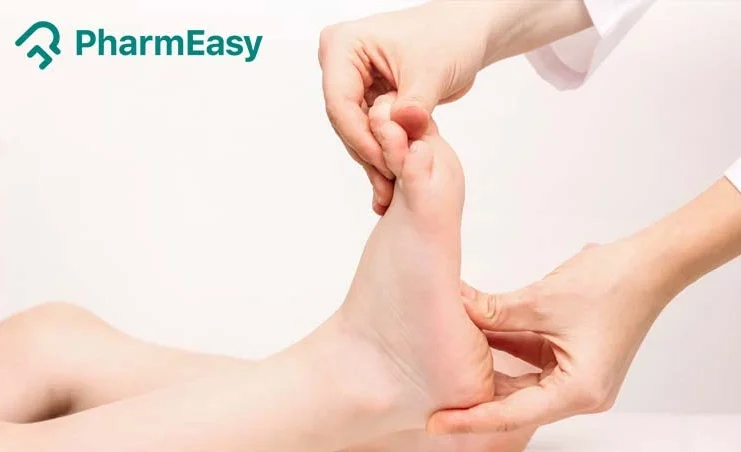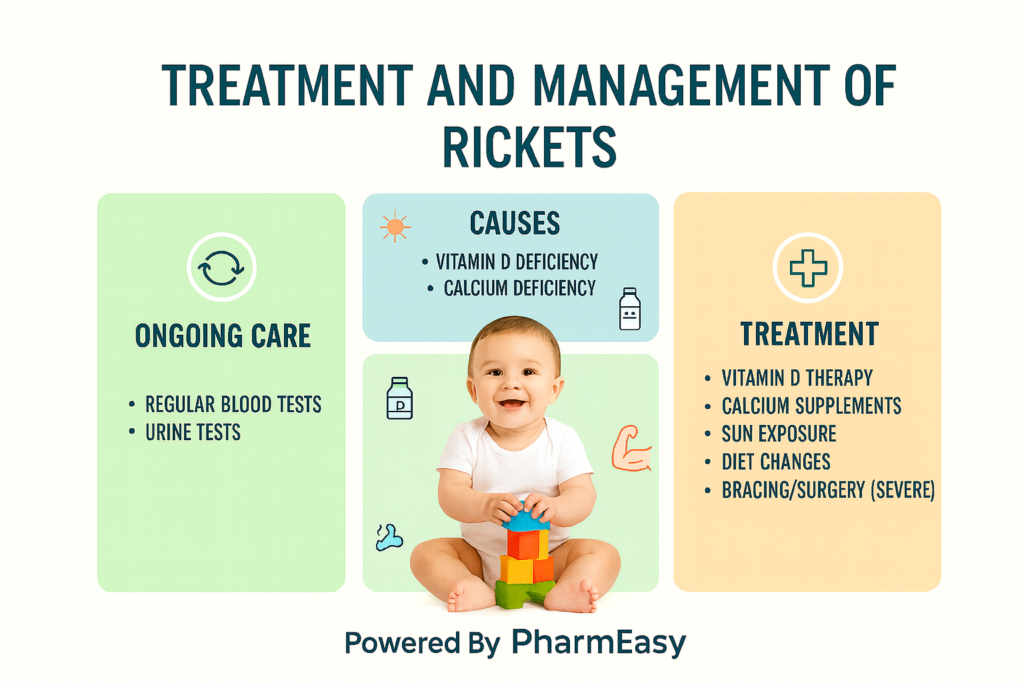Rickets in Children: Causes, Symptoms, Types & Treatment
By Dr. Anmol Batra +2 more

Get,

to manage your symptom
Get your,


4 Cr+ families
benefitted

OTP sent to 9988776655



You’ve successfully subscribed to receive
doctor-approved tips on
Whatsapp

Get ready to feel your best.

Hi There,
Download the PharmEasy App now!!


Register to Avail the Offer
Send OTPBy continuing, you agree with our Privacy Policy and Terms and Conditions

Hi There,
Sign up on PharmEasy now!!
Trusted by 4 crore+ families

OTP sent to 9988776655



You have unlocked 25% off on medicines




Code: NU25
By Dr. Anmol Batra +2 more
Table of Contents
One of the most common nutritional deficiencies observed in otherwise healthy, growing children is vitamin D deficiency1. A multicentre study across six Indian states involving over 2,500 children (5 to 18 years) found that only 36.8% showed sufficient levels of vitamin D2. Despite India’s abundant sunlight, this deficiency remains highly prevalent and can significantly affect bone health and overall growth.
Vitamin D, along with calcium and phosphorus, plays a vital role in bone maturation and mineralisation. Thus, inadequate levels of these nutrients could impair proper bone formation, which may lead to conditions like rickets3.

Through this article, we aim to highlight the importance of addressing vitamin D deficiency and preventing rickets disease in the growing population.
Rickets is a bone disorder that causes the bones of growing children to become soft and weak4.
It occurs when the mineralisation (a process that makes bones strong and rigid) of the growing parts of bones, known as the epiphyseal plates, is defective. In simple terms, this means the bones do not harden properly as they grow.
Rickets can be inherited (genetic) or acquired (nutritional), with nutritional rickets being the most common form seen worldwide3.
Vitamin D plays a vital role in maintaining healthy bones by regulating the body’s levels of calcium and phosphorus, the two main minerals responsible for bone strength and structure. It helps the intestines and kidneys absorb calcium and phosphorus from food and urine and ensures that these minerals are properly deposited in growing bones.
When vitamin D levels are low, the body cannot absorb enough calcium and phosphorus. As a result, bones become soft, weak, and poorly mineralised, leading to rickets in children and osteomalacia in adults. The lack of vitamin D also triggers an increase in parathyroid hormone (PTH), which draws calcium out of bones to maintain normal blood levels, further weakening the skeleton4.
Therefore, ensuring sufficient vitamin D during growth years is crucial to prevent rickets disease, promote bone development, and support overall skeletal health.
Rickets often develops gradually as bones weaken and can affect multiple parts of a child’s body. Common rickets symptoms include3,5:
Children with rickets disease may also develop skeletal deformities, such as5:
Note: Children with rickets are often smaller for their age, and their teeth may appear later than usual6. Thus, early recognition of rickets symptoms is essential to prevent long-term bone deformities and complications.
The most common cause of rickets is a deficiency of vitamin D, which is essential for calcium and phosphorus absorption and bone mineralisation. In some cases, low calcium or phosphorus intake may also lead to rickets.
Rickets disease may be nutritional (acquired) or genetic (inherited)3:
Rickets most often develops when the body does not get or use enough vitamin D, calcium, or phosphorus, leading to weak and poorly mineralised bones. Children are at a higher risk if they3,5:
If rickets disease is not treated in time, it can lead to3:
If the deficiency becomes severe, low calcium levels can lead to3:
If left untreated, these complications may progress and become life-threatening.
Diagnosis of rickets is based on clinical evaluation, biochemical investigations, and radiological findings. A detailed medical history and thorough physical examination are essential to identify underlying causes and assess disease severity.
Laboratory investigations help confirm the diagnosis. Basic tests include3,5:
Radiological evaluation (especially X-rays) is also performed to confirm characteristic bone changes, particularly at rapidly growing sites such as the wrists, knees, and ribs.

Treatment depends on the cause, most commonly a vitamin D or calcium deficiency. The main goals are to correct the deficiency, strengthen bones, and prevent deformities.
Ongoing care3:
Note: Genetic forms of rickets are best managed under the care of a paediatric endocrinologist or a metabolic bone specialist.
Rickets is caused by vitamin D deficiency and is largely preventable through proper nutrition, sunlight exposure, and supplementation. Key preventive measures include:
Early medical attention is important to prevent permanent bone damage and complications. Consult a doctor immediately if your child shows3:
Also Read: Caring for a Baby with Blocked Nose: Simple Tips for Parents
Rickets is a preventable and treatable condition that primarily results from vitamin D or calcium deficiency.
Early recognition through clinical evaluation, biochemical tests, and radiological findings is key to effective management. In addition to this, adequate nutrition, sunlight exposure, and timely supplementation during pregnancy and childhood play vital roles in preventing rickets in children. Therefore, parents should keep in mind that with prompt diagnosis and proper treatment, children with rickets can achieve normal growth, strong bones, and healthy development.
Yes, rickets can be corrected if detected early. A guided treatment with vitamin D, calcium supplements, and adequate sunlight exposure helps strengthen bones and correct deformities over time3.
Most cases are due to vitamin D or calcium deficiency (nutritional rickets), but some rare forms are genetic, caused by inherited problems in vitamin D metabolism or phosphate handling3.
Anti-rickets refers to nutrients or treatments that prevent or cure rickets10. These are mainly vitamin D, calcium, and phosphorus. They help maintain strong and healthy bones.
Bow legs can be a symptom of rickets, especially in children with soft or weak bones. However, not all bow legs are due to rickets; sometimes, they occur as a normal stage of growth11.
In most cases, rickets is reversible with early treatment using vitamin D and calcium. However, long-standing or severe deformities may need braces or surgery for correction3.
Disclaimer: The information provided here is for educational/awareness purposes only and is not intended to be a substitute for medical treatment by a healthcare professional and should not be relied upon to diagnose or treat any medical condition. The reader should consult a registered medical practitioner to determine the appropriateness of the information and before consuming any medication. PharmEasy does not provide any guarantee or warranty (express or implied) regarding the accuracy, adequacy, completeness, legality, reliability or usefulness of the information; and disclaims any liability arising thereof.
Links and product recommendations in the information provided here are advertisements of third-party products available on the website. PharmEasy does not make any representation on the accuracy or suitability of such products/services. Advertisements do not influence the editorial decisions or content. The information in this blog is subject to change without notice. The authors and administrators reserve the right to modify, add, or remove content without notification. It is your responsibility to review this disclaimer regularly for any changes.
Comments

Leave your comment...
You may also like
Comments